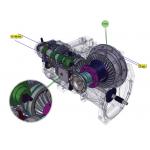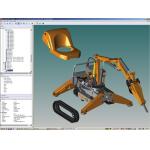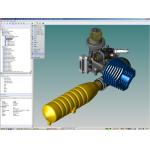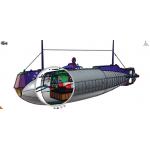Latest News
August 1, 2005
By Mark Clarkson
Many commercial MCAD programs provide free applications that allow users—and their suppliers and customers—to view, measure, and print from their native files. So why do we still need third-party viewers?
Visualization Won’t Cut It
“Just having visualization capability doesn’t necessarily meet the customer’s needs these days,” says Lynne Saunders, a VP at Actify. Users “are asking for more and more functionality as their responsibilities are broadening. As the need for continual collaboration and communication throughout the enterprise and across the supply chain, is increasing, they need to effectively communicate the design data, both 2D and 3D, and to ensure the security of that data as they send it beyond their own enterprise and around the world.”
|
|
|
This gearbox is being viewed and measured in Seemage, which aims to let users manipulate big assemblies in an intuitive way. |
This collaboration starts with the ability to mark up MCAD drawings, adding notes and symbols and whatnot, but goes beyond that. Viewing and markup software is expanding to become a sort of PDM/PLM “lite.” The result goes by different names; Actify calls it “digital design and communication,” and offers a suite of applications for it. “It encompasses CAD viewing and markup,” says Actify CEO Randy Ochs, “but it goes beyond the design and manufacturing workspace, into intellectual rights management, file security, workflow management, and auditability. When that design comes full circle, you need to be able to track which suppliers or customers have added which markups and supporting documents.”
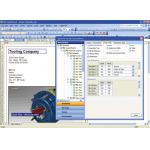
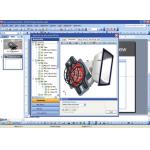
Using Actify’s SpinFire for MS Office, an interactive .3D (containing 3D and 2D data) file is embedded into PowerPoint for a customer assembly demo. Actify's Publisher works with major MCAD formats as well as with standard Microsoft Office products, such as Excel, PowerPoint, and Word, left to right above and the image below. Click on an image to enlarge.
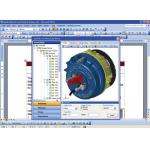
Neutral, Like Switzerland
One consequence, both of the expanding role of MCAD data and of the persistent multitude of MCAD file types, is the rise of the neutral file format as a container for moving MCAD data around.
Generally, an application such as Actify’s Publisher might read a native 3D MCAD file and spit out a neutral file containing lightweight, compressed version of the original part or assembly. Or an application such as AutoCAD might export a neutral file directly. But a neutral file can, at least in theory, serve as a container for any kind of file, or any combination of files: 2D CAD drawings, multiple 3D models from different MCAD applications, PDFs from a supplier’s catalog, bill of materials data in XML form, JPEG and TIFF images, diverse assorted Word documents and Excel spreadsheets—you name it.
|
|
|
Autodesk's neutral file of choice is its own open DWF format. DWF lets users who might not have an MCAD program get at all the data contained in an MCAD file, even when large assemblies are involved. |
A whole cloud of relevant documents and data can follow the part around, and your interlocutors can add to it as it goes.
In fact, says Autodesk's Jonathan Knowles, “Today the model is actually a database, which can be repurposed for a variety of things. People expect to be able to reuse data throughout the life of the product, and on other products down the line.”
Many people along the supply chain who need access to the information and knowledge contained within the MCAD data don’t always have the MCAD program it was created in. What they generally do have is Microsoft Office, and a consequent desire to use MCAD data in their Word, Excel, and PowerPoint documents. The level of integration provided by different vendors ranges from simply reading XML data from within the neutral file to embedding thousand-part assemblies complete with interactive cutting planes and 3D animations inside a single PowerPoint slide.
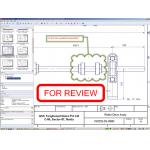
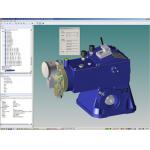
Images courtesy of Autodesk.
Big Files and Plenty of Them
If you put all that data into a neutral file, you’d better be able to find it again. Navigating a huge drawing or assembly is considerably harder than finding your way around your typical Office document.
“How,” Stephanie Hanes of Bluebeam wonders, “do you make it easy to scroll through hundreds of drawings, so that you are viewing only the drawing you want at any given time, but can toggle easily between related drawings? How do you easily navigate large drawings, 100 inches wide? Our customers tell us these issues make it difficult for them to switch to the digital workflow,” she says. “It can be so frustrating that people would rather spend the money to print it out. We want to get engineers off of paper, in a way that actually saves them time.”
Bluebeam’s focus is on easily navigating large-format MCAD drawings on the computer, but the same issues are present in, say, large 3D assemblies. “The user needs to be able to visualize and manipulate big assemblies in a very intuitive way,” says Eric Piccuezzu, CEO and founder of Seemage. Performance is also key to ease of use. “The program must work well,” says Piccuezzu, “not only on a model with 100 parts, but on a model with 10,000 parts. That is very important. It lets people make decisions in the full context.”
The ability to easily convert and publish large batches of files is also a benefit. A single part might have 500 drawings associated with it; you don’t want to convert those one at a time. Even better is the ability to watch folders for incoming files, and publish them automatically.
Open Or Closed?
|
|
|
Image courtesy of Autodesk. |
Although the basic idea of neutral files as containers for related MCAD documents is the same, different vendors take different approaches to the “openness” of their files. Actify and Seemage, for example, use their own proprietary formats. Bluebeam, on the other hand, uses PDFs as its neutral file of choice. Autodesk's products use that company’s own, open, DWF format. DWF files are, in fact, ZIP archives, and you can open them with WinZip or StuffIt.
|
|
|
Seemage's patented Digger tool lets you drill down into complex assemblies. Here the tool is illustrated by the inset of the submarine’s interior. Click image to enlarge. |
“I want to know that I can get at that information ten years from now,” says Autodesk's Knowles, “regardless of the health of Autodesk.”
Whichever format you use, your native MCAD data remains securely behind the firewall, which is one big advantage of sending a neutral file in the first place. Applications that publish neutral files generally give you some measure of additional security, as well, allowing you to specify which parts and pages a recipient can view, and whether he or she is allowed to make measurements or to add markups.
Neutral files are smaller than native MCAD files, they are more secure, and they are more robust. Of course, they do give you yet another file type to manage. Sorry about that.
Writer and artist Mark Clarkson’s latest book is Photoshop Elements by Example. Visit him on the Web at markclarkson.com or send e-mail about this article by clicking here. Please reference September 2005 Neutral Formats in your message.
Product Information
Actify, Inc.
San Francisco, CA
Autodesk, Inc.
San Rafael, CA
Bluebeam Software, Inc.
Pasadena, CA
Kubotek USA, Inc.
Marlborough, MA
Seemage
Sofia Antipolis, France
More Bluebeam Software Coverage
Subscribe to our FREE magazine, FREE email newsletters or both!
Latest News
About the Author
Mark ClarksonContributing Editor Mark Clarkson is Digital Engineering’s expert in visualization, computer animation, and graphics. His newest book is Photoshop Elements by Example. Visit him on the web at MarkClarkson.com or send e-mail about this article to [email protected].
Follow DE






